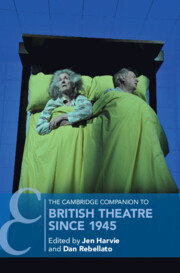Book contents
- The Cambridge Companion to British Theatre since 1945
- Cambridge Companions to Theatre and Performance
- The Cambridge Companion to British Theatre since 1945
- Copyright page
- Contents
- Illustrations
- Contributors
- Acknowledgements
- Chronology of British Theatre since 1945
- Introduction
- Part I Theatre Makers
- Part II Theatre Sectors
- Part III Theatre Communities
- Chapter 7 Audiences
- Chapter 8 Black British Theatre
- Chapter 9 Queer Theatre
- Part IV Theatre and State
- Further Reading
- Index
- Other Volumes in the Series of Cambridge Companions (continued from p.ii)
Chapter 7 - Audiences
Ownership, Interaction, Agency
from Part III - Theatre Communities
Published online by Cambridge University Press: 14 March 2024
- The Cambridge Companion to British Theatre since 1945
- Cambridge Companions to Theatre and Performance
- The Cambridge Companion to British Theatre since 1945
- Copyright page
- Contents
- Illustrations
- Contributors
- Acknowledgements
- Chronology of British Theatre since 1945
- Introduction
- Part I Theatre Makers
- Part II Theatre Sectors
- Part III Theatre Communities
- Chapter 7 Audiences
- Chapter 8 Black British Theatre
- Chapter 9 Queer Theatre
- Part IV Theatre and State
- Further Reading
- Index
- Other Volumes in the Series of Cambridge Companions (continued from p.ii)
Summary
This chapter charts the impact of the establishment of systematic state funding on the nature of the relationship between theatre goers and theatre makers; the forms of theatre available to audiences; and theatre makers’ attitudes towards theatregoers. Citing Baumol and Bowen’s 1960s survey of British theatregoers – which noted their exceptionally elite status – it discusses the social, technological, and cultural shifts which have shaped the opportunities for greater audience interaction, agency, and ownership in recent years. Touching on the building of new civic, repertory, and university theatres in the regions between the 1950s and 1980s, the health and status of touring theatre companies, and efforts to create more accessible and inclusive experiences, the chapter acknowledges that the period since 1945 has seen extraordinary developments in the understanding of what being an audience means, in terms of visibility, conventions governing behaviour, marketing, opportunities for participation, and assumptions about what constitutes an appropriate place for the encounter between performer and spectator. It concludes, however, that twenty-first century British theatre still has some way to go before it can claim to have addressed its reputation for elitism and exclusivity.
- Type
- Chapter
- Information
- The Cambridge Companion to British Theatre since 1945 , pp. 147 - 165Publisher: Cambridge University PressPrint publication year: 2024

